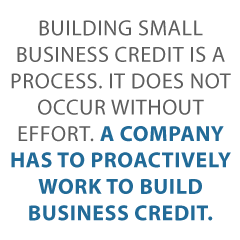- Connect With Us!
- (877) 600-2487
- info@creditsuite.com
Why You Need to Separate Your Commercial and Consumer Credit
Published By Janet Gershen-Siegel at October 29th, 2017
You may have a new small business, or are now connected because you invested in one. Or maybe you have suddenly become an owner or a manager. No matter what, here is why you need to separate your commercial and consumer credit.
Separate Your Commercial and Consumer Credit and Protect Your Personal Assets
Small business credit is credit in a small business’s name. It doesn’t link to an owner’s personal credit, not even if the owner is a sole proprietor and the sole employee of the small business.
Consequently, an entrepreneur’s business and personal credit scores can be very different.
The Advantages When You Separate Your Commercial and Consumer Credit
Given that business credit is distinct from personal, it helps to secure a small business owner’s personal assets, in case of litigation or business insolvency.
Also, with two distinct credit scores, a small business owner can get two different cards from the same vendor. This effectively doubles buying power.
Another benefit is that even new ventures can do this. Going to a bank for a business loan can be a recipe for disappointment. But building business credit, when done properly, is a plan for success.
Consumer credit scores depend on payments but also various other factors like credit use percentages.
But for business credit, the scores truly merely hinge on if a small business pays its debts on time.
Separate Your Commercial and Consumer Credit: The Process
Process
Building small business credit is a process. It does not occur without effort. A company has to proactively work to build business credit.
However, it can be done readily and quickly, and it is much faster than developing personal credit scores.
Vendors are a big component of this process.
Undertaking the steps out of sequence leads to repetitive denials. No one can start at the top with company credit. For instance, you can’t start with retail or cash credit from your bank. If you do, you’ll get a denial 100% of the time.
Separate Your Commercial and Consumer Credit and Build Small Business Fundability
A company needs to be fundable to lending institutions and vendors.
Therefore, a small business needs a professional-looking website and email address. And it needs to have website hosting from a supplier such as GoDaddy.
In addition, company telephone and fax numbers must have a listing on 411. You can do that here: http://www.listyourself.net.
Additionally, the company phone number should be toll-free (800 exchange or similar).
A company also needs a bank account dedicated purely to it, and it has to have all of the licenses essential for operating.
Licenses
These licenses all have to be in the particular, appropriate name of the small business. And they must have the same small business address and phone numbers.
So keep in mind, that this means not just state licenses, but possibly also city licenses.
Learn more here and get started with building small business credit with your company’s EIN and not your SSN.
Separate Your Commercial and Consumer Credit by Dealing with the Internal Revenue Service
Visit the IRS website and get an EIN for the business. They’re free of charge. Select a business entity like corporation, LLC, etc.
A small business can begin as a sole proprietor. But they probably want to change to a form of corporation or an LLC.
This is to minimize risk. And it will take full advantage of tax benefits.
A business entity matters when it pertains to taxes and liability in the event of litigation. A sole proprietorship means the owner is it when it comes to liability and tax obligations. No one else is responsible.
Sole Proprietors Take Note: You Need to Separate Your Commercial and Consumer Credit
If you operate a small business as a sole proprietor, then at least be sure to file for a DBA. This is ‘doing business as’ status.
If you do not, then your personal name is the same as the business name. Consequently, you can find yourself being personally liable for all small business debts.
And also, per the Internal Revenue Service, with this structure there is a 1 in 7 chance of an IRS audit. There is a 1 in 50 probability for corporations! Steer clear of confusion and noticeably lower the chances of an IRS audit at the same time.
Separate Your Commercial and Consumer Credit and Start Off the Business Credit Reporting Process
Begin at the D&B web site and get a cost-free D-U-N-S number. A D-U-N-S number is how D&B gets a business in their system, to produce a PAYDEX score. If there is no D-U-N-S number, then there is no record and no PAYDEX score.
Once in D&B’s system, search Equifax and Experian’s web sites for the small business. You can do this at fastcs.wpengine.com/reports. If there is a record with them, check it for accuracy and completeness. If there are no records with them, go to the next step in the process.
In this way, Experian and Equifax have something to report on.
Vendor Credit Tier
First you should establish trade lines that report. This is also known as the vendor credit tier. Then you’ll have an established credit profile, and you’ll get a business credit score.
And with an established business credit profile and score you can begin to get credit in the retail and cash credit tiers.
These sorts of accounts often tend to be for the things bought all the time, like marketing materials, shipping boxes, outdoor workwear, ink and toner, and office furniture.
But first off, what is trade credit? These trade lines are credit issuers who give you starter credit when you have none now. Terms are in most cases Net 30, rather than revolving.
So, if you get an approval for $1,000 in vendor credit and use all of it, you need to pay that money back in a set term, such as within 30 days on a Net 30 account.
Details
Net 30 accounts have to be paid in full within 30 days. 60 accounts must be paid in full within 60 days. In comparison with revolving accounts, you have a set time when you have to pay back what you borrowed or the credit you used.
To launch your business credit profile the right way, you ought to get approval for vendor accounts that report to the business credit reporting agencies. As soon as that’s done, you can then make use of the credit.
Then repay what you used, and the account is on report to Dun & Bradstreet, Experian, or Equifax.
Vendor Credit Tier – It Makes Sense
Not every vendor can help in the same way true starter credit can. These are vendors that grant an approval with marginal effort. You also want them to be reporting to one or more of the big three CRAs: Dun & Bradstreet, Equifax, and Experian.
You want 5 to 8 of these to move onto the next step, which is the retail credit tier. But you may need to apply more than once to these vendors. So, this is to validate you are reliable and pay promptly. Here are some stellar choices from us: https://oldcs.creditsuite.com/blog/5-vendor-accounts-that-build-your-business-credit/
Accounts That Don’t Report
Non-reporting trade accounts can also be helpful. While you do want trade accounts to report to at least one of the CRAs, a trade account which does not report can still be of some value.
You can always ask non-reporting accounts for trade references. And also credit accounts of any sort ought to help you to better even out business expenses, thus making budgeting easier. These are providers like PayPal Credit, T-Mobile, and Best Buy.
Retail Credit Tier
Once there are 5 to 8 or more vendor trade accounts reporting to at least one of the CRAs, then progress to the retail credit tier. These are companies such as Office Depot and Staples.
Just use your Social Security Number and date of birth on these applications for verification purposes. For credit checks and guarantees, use the business’s EIN on these credit applications.
One good example is Lowe’s. They report to D&B, Equifax and Business Experian. They need to see a D-U-N-S and a PAYDEX score of 78 or more.
Fleet Credit Tier
Are there 8 to 10 accounts reporting? Then progress to the fleet credit tier. These are companies like BP and Conoco. Use this credit to buy fuel, and to fix, and take care of vehicles. Only use your SSN and date of birth on these applications for verification purposes. For credit checks and guarantees, make certain to apply using the business’s EIN.
One such example is Shell. They report to D&B and Business Experian. They need to see a PAYDEX Score of 78 or better and a 411 company phone listing.
Shell might claim they want a specific amount of time in business or revenue. But if you already have enough vendor accounts, that won’t be necessary. And you can still get approval.
Learn more here and get started with building small business credit with your company’s EIN and not your SSN.
Cash Credit Tier
Have you been sensibly handling the credit you’ve up to this point? Then move to the cash credit tier. These are businesses such as Visa and MasterCard. Just use your Social Security Number and date of birth on these applications for verification purposes. For credit checks and guarantees, use your EIN instead.
One such example is the Fuelman MasterCard. They report to D&B and Equifax Business. They want to see a PAYDEX Score of 78 or more. And they also want you to have 10 trade lines reporting on your D&B report.
Plus, they want to see a $10,000 high credit limit reporting on your D&B report (other account reporting).
Also, they want you to have an established company.
These are service providers such as Walmart and Dell, and also Home Depot, BP, and Racetrac. These are frequently MasterCard credit cards. If you have 14 trade accounts reporting, then these are in reach.
Separate Your Commercial and Consumer Credit and Monitor Your Business Credit
Know what is happening with your credit. Make certain it is being reported and take care of any errors ASAP. Get in the practice of taking a look at credit reports and digging into the particulars, and not just the scores.
We can help you monitor business credit at Experian and D&B for 90% less than it would cost you at the CRAs. See: fastcs.wpengine.com/monitoring. And at Equifax, you can monitor your account at: www.equifax.com/business/business-credit-monitor-small-business. Equifax costs about $19.99.
Update Your Record
Update the information if there are errors or the information is incomplete. At D&B, you can do this at: https://iupdate.dnb.com/iUpdate/viewiUpdateHome.htm . For Experian, go here: www.experian.com/small-business/business-credit-information.jsp . So for Equifax, go here: www.equifax.com/business/small-business.
Learn more here and get started with building small business credit with your company’s EIN and not your SSN.
Separate Your Commercial and Consumer Credit and Fix Your Business Credit
So, what’s all this monitoring for? It’s to contest any mistakes in your records. Mistakes in your credit report(s) can be fixed. But the CRAs often want you to dispute in a particular way.
Get your company’s PAYDEX report at: www.dnb.com/about-us/our-data.html. Get your company’s Experian report at: www.businesscreditfacts.com/pdp.aspx?pg=SearchForm. And get your Equifax business credit report at: www.equifax.com/business/credit-information.
Disputes
Disputing credit report inaccuracies typically means you send a paper letter with duplicates of any proof of payment with it. These are documents like receipts and cancelled checks. Never send the originals. Always send copies and keep the originals.
Fixing credit report errors also means you specifically detail any charges you challenge. Make your dispute letter as clear as possible. Be specific about the issues with your report. Use certified mail to have proof that you mailed in your dispute.
Dispute your or your business’s Equifax report by following the directions here: www.equifax.com/small-business-faqs/#Dispute-FAQs.
You can dispute errors on your or your business’s Experian report by following the instructions here: www.experian.com/small-business/business-credit-information.jsp.
And D&B’s PAYDEX Customer Service telephone number is here: www.dandb.com/glossary/paydex.
A Word about How to Separate Your Commercial and Consumer Credit
Always use credit smartly! Don’t borrow beyond what you can pay off. Keep track of balances and deadlines for repayments. Paying punctually and in full does more to raise business credit scores than pretty much anything else.
Growing company credit pays off. Good business credit scores help a business get loans. Your loan provider knows the business can pay its debts. They understand the business is authentic.
The business’s EIN attaches to high scores and lenders won’t feel the need to ask for a personal guarantee.
Separate Your Commercial and Consumer Credit: Takeaways
Business credit is an asset which can help your company for many years to come. Learn more here and get started toward building company credit.

 " class="attachment-blog-single size-blog-single wp-post-image" alt="Get Business Credit Cards for New Businesses Credit Suite-Business Line of Credit Decoded" title="Get Business Credit Cards for New Businesses">>
" class="attachment-blog-single size-blog-single wp-post-image" alt="Get Business Credit Cards for New Businesses Credit Suite-Business Line of Credit Decoded" title="Get Business Credit Cards for New Businesses">>